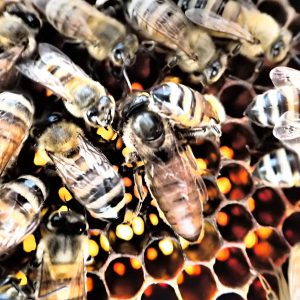Celebrating honey bees
Honey bees deserve their day in the sun. After all, they work most daylight hours and their jobs never seem to end. They are working from the moment they chew their way out of the cell they developed in, until the day they bring their last load of nectar and pollen to the hive. One of the major accomplishments of the honey bee is its pollinating services. It is claimed that they supply between 25 % and 33 % of the food we eat by pollinating many crops. Our choice of fruits and vegetables would be meager without them.
Sweet deal
Let us not forget the honey they make. It has also been said that one bee would need to make a million trips to flowers to have enough nectar to make one pound of honey. Since one bee could never make that many trips during its life, it might only bring in enough to make one teaspoon of honey. Next time you spread some honey on a biscuit, remember that you are eating the lifetime’s work of a couple of honey bees!
Working hard for the honey

The honey bee holds a special place in the hearts of many, but few know the complex nature of a bee’s life and the sheer magnitude of what they accomplish. To do their work, other jobs back at the hive must be taken care of. From the moment a bee emerges from the comb cell where it developed, it begins its work. Its first job is to clean its own cell then it becomes a nurse bee and feeds the developing bees. They must be fed and kept warm so they can develop. Worker bees keep the young bee larvae, known as brood, at between 93 and 94 degrees. They vibrate their wings to create heat or move cooler air across the brood. The middle of the hive, where the brood is, is the busiest place in the hive. Throughout a worker bee’s life, it changes jobs as it gets older. As a worker bee’s life continues, its jobs include wax architect, queen tender, guard bee, undertaker, and finally, forager of nectar and pollen. The name for this age-related separation of labor is called temporal polytheism.
Boys will be boys
The hive consists mostly of female workers, a queen, and a small number of drones or male bees. The workers do all the work, the queen lays eggs, and the drones are only around to mate. Drones spend their days at drone congregation sites hanging out with other drones from other hives. There they wait for a virgin queen to fly by on one, of possibly several, of her mating flights. The drones pursue the queen and if one catches her, the mating occurs in mid-flight. Only a few of them will be successful. Those drones that succeed, die shortly after mating. The queen flies on and will mate with 15 or more different drones during one to several flights. Once she is mated, and laying eggs in her hive, she will never need to mate again.
Learn about Honey bees!
Although National Honey Bee Day has passed, we can still celebrate the honey bee and all they do for us. One way to do this is to join us on September 9th from 8:30 am – 12:30 pm at the Bert J Harris Agricultural Center, Sam Polston Auditorium in Sebring for a three-hour introduction to honey bees and their care. If you have wondered if beekeeping is for you; this would be the class to take. The cost is $25 and includes a year’s membership to the Heartland Beekeepers Association. Better yet this gives you access to the monthly field days where you can come, put on a bee suit, and find out firsthand if you are ready to be a beekeeper. Click here to register. Becoming a beekeeper is a great way to support honey bees!
Stay in touch!
That’s what’s new from the Hometown Gardener.
Like and Follow me on Facebook at Hometown Gardener
Sign up for our Highlands County Master Gardener Volunteer, “Putting Down Root” Newsletter Here
Read my other blogs by clicking here.
Join our Facebook groups Highlands County Master Gardeners, Science-Based Florida Gardening Answers, Central Florida Butterfly and Pollinator Club, and Heartland Beekeepers
 0
0
